Can you freeze green beans? Yes, you can…and they taste amazing! Learn how to freeze green beans in no time with this easy step by step tutorial!

One of the ways that I save quite a bit of money on groceries is by preserving lots of fruits and vegetables.
While we live in the city and don’t have room for a big garden, we’re blessed to live in an area where we can get lots of beautiful, homegrown produce for great prices. So I simply buy large amounts from local growers and then preserve them for us to enjoy all year long.
I know that canning and freezing produce sounds really daunting to many people, so I’ve done a number of step by step canning and freezing tutorials to show you just how simple the process really is.
Today I’m going to show you how to freeze green beans. Not only are they super easy to preserve by freezing, they also taste so much better than store-bought!
In fact, recently I saw a great deal on some frozen beans at the store and decided to buy a couple of bags thinking it would help stretch our supply since I hadn’t frozen as many this year as I probably should have.
I made them for dinner and after one bite my husband commented, “It’s no wonder so many people don’t like vegetables!”
And I had to agree. They just were nowhere near as tasty as the green beans that I freeze!
The benefits of freezing green beans vs. canning them
There are affiliate links in this post. As an Amazon Associate, I earn from qualifying purchases. Please read my full disclosure policy.
You can preserve your beans by canning or freezing them. If you choose to can them, you need to use a pressure canner since using a regular canner doesn’t reach high enough temps to kill the bacteria that causes botulism.
I find the pressure canning process rather time-consuming and tedious plus it also makes the beans less nutritious. Did you know that frozen veggies and fruit have almost as much nutritional value as when they are fresh?
So, I prefer to simply freeze our green beans. And once you see how amazingly easy it is to do, I think you’ll understand why!
Supplies for freezing green beans
- Dishpan or container to put the beans in
- Paring Knife (love this one!)
– You can also use your fingers to do this, but I find it harder and it doesn’t look as nice either. - Blancher
– You can use a big pot instead but it gets a bit complicated when it comes time to drain the beans and cool them quickly
(Don’t have a blancher and don’t want to buy one? See if you can find a friend that has one that you could borrow.) - Freezer bags or freezer-safe containers to store the beans
– I like using these freezer boxes.
How to Freeze Green Beans
1. Trim the bean ends
Remove the ends of the beans and any defective spots. If you have true “string” beans, remove the strings too.
Technically you don’t have to remove the tail end of the bean, just the end that was attached to the stalk. However, I don’t like the look of leaving them on so I remove them too.
2. Cut the beans into smaller pieces
Break or cut the beans into 1 to 1 ½ inch pieces.
If you have children, this is a step that even little children can help with. In fact, they often think it is fun!
3. Wash the beans.
Wash the beans thoroughly in cold water. I like to put a dishpan full of beans in my sink and then just fill it with water.
Swish the beans around really well to work any dirt loose.
4. Fill the blancher’s colander
Move the beans over to the colander insert of your blancher, filling it to just below the ridge.
You want the beans to not go above the top row of holes so that they will be covered with water during the blanching process.
5. Fill the blancher with water
Fill the kettle part of the blancher about 2/3 to 3/4 full of water. You don’t want it too full because the water level will rise once you put the colander full of beans into it.
Bring the water to a full, rolling boil.
6. Insert the colander into the boiling water
Slowly (this is important so that the water doesn’t go splashing out!) insert the colander full of beans into the boiling water. Once you put the beans in, the water will stop boiling.
7. Bring the pot to a rolling boil
Watch the pot carefully and once the water comes to a rolling boil again, remove the beans immediately. You just want to slightly cook the beans.
(In the picture above I wasn’t watching the pot closely enough and it had been boiling for a bit when I noticed it. You don’t want that much of a boil! It isn’t tragic, but the beans just won’t taste quite as good.)
8. Cool the beans
While you are waiting for the beans to boil, fill a dishpan or sink with cold water- the colder the better.
Once you remove the beans from the boiling water, immerse the colander in the cold water, making sure that all the beans are submerged.
Cool the beans down as fast as possible. It helps to swish the colander around in the water, keep the water running, use your hands to move the beans around and even change the water if necessary.
9. Drain the beans
Once the beans are nice and cool, drain the water off of them.
10. Transfer beans to freezer-safe containers
Put the blanched beans in freezer bags or freezer-safe containers and freeze immediately.
I typically use these freezer boxes to freeze our food just because I like the way they store and it’s also cheaper in the long run since you can use them over and over again.
And that’s all there is to freezing green beans! So easy, but it produces such tasty beans.
Also, while we’re on the subject of green beans, I highly recommend this amazing Cheesy Ham, Potato and Green Bean Casserole. It’s made totally from scratch and is total comfort food!
How to Freeze Fresh Green Beans
Equipment
- Dishpans or containers to put the beans in
- Paring Knife
- Blancher
- Freezer bags or freezer safe containers to freeze the beans in
Ingredients
- Green Beans
Instructions
- Remove the ends of the beans and any defective spots. If you have true “string” beans, remove the strings too. Technically you don’t have to remove the tail end of the bean, just the end that was attached to the stalk. However, I don’t like the look of leaving them on so I remove them too.
- Break or cut the beans into 1 to 1 ½ inch pieces.
- Wash the beans thoroughly in cold water. I like to put a dishpan full of beans in my sink and then just fill it with water. Swish the beans around really good to work any dirt loose.
- Move the beans over to the colander insert of your blancher, filling it to just below the ridge. Basically you want the beans to not go above the top row of holes so that they will be covered with water during the blanching process.
- Fill the kettle part of the blancher about 2/3 to 3/4 full of water. You don’t want it too full because the water level will rise once you put the colander full of beans into it. Bring the water to a full, rolling boil.
- Slowly (this is important so that the water doesn’t go splashing out!) insert the colander full of beans into the boiling water. Once you put the beans in, the water will stop boiling.
- Watch the pot carefully and once the water comes to a rolling boil again, remove the beans immediately. You basically just want to slightly cook the beans.
- While you are waiting for the beans to boil, fill a dishpan or sink with cold water- the colder the better. Once you remove the beans from the boiling water, immerse the colander into the cold water, making sure that all the beans are submerged. Cool the beans down as fast as possible. It helps to swish the colander around in the water, keep the water running, use your hands to move the beans around and even change the water if necessary.
- Once beans are nice and cool, drain the water off of them.
- Put the blanched beans in freezer bags or freezer-safe containers and freeze immediately.
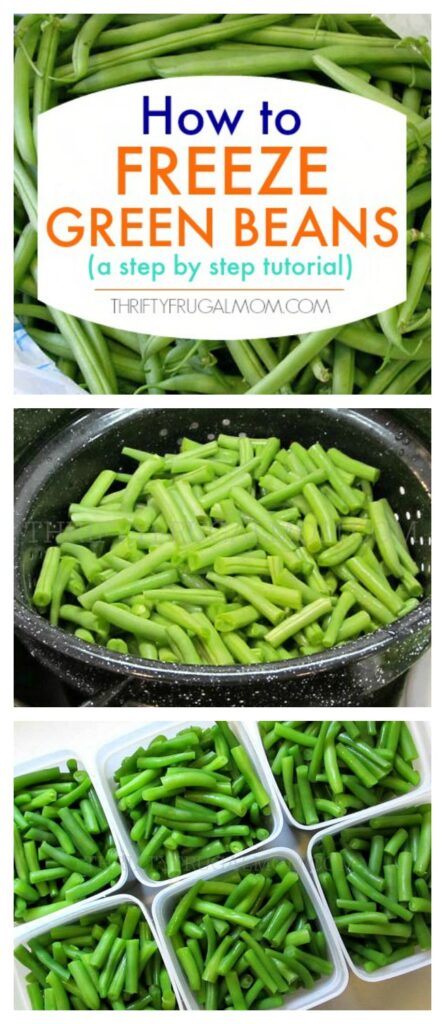


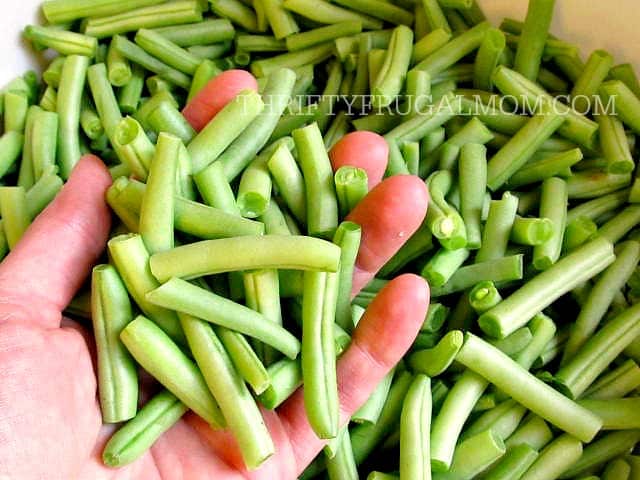

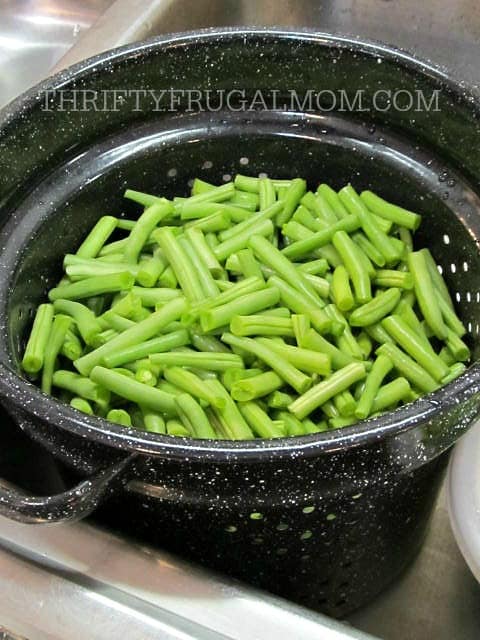
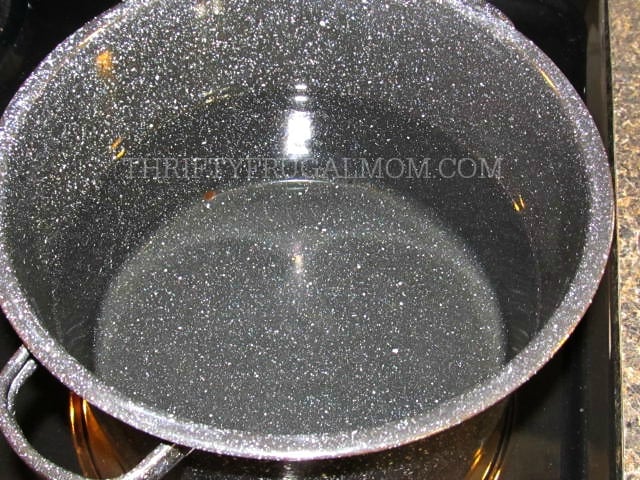
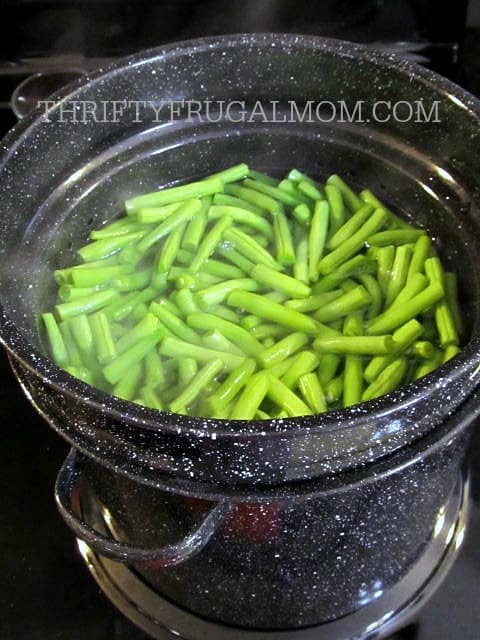



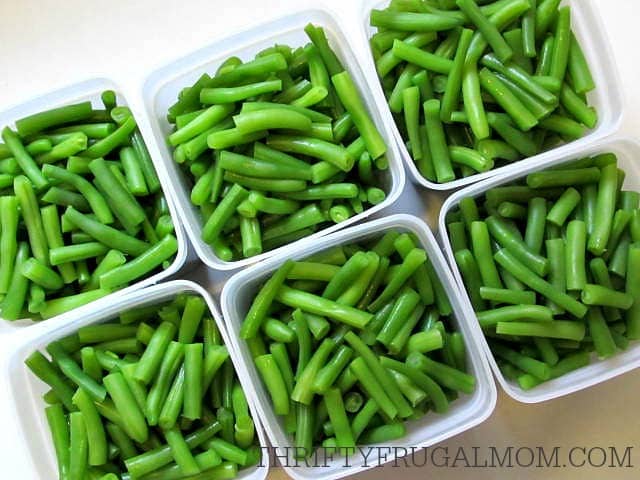


sharren
Can v not just wash ,cut n freeze instead of blanching them?
ThriftyFrugalMom
Sharren, it’s not advised. The best way I know to explain it is that blanching stops the process of deterioration, which helps to keep them tasting fresh and keep their nutrition. If you don’t blanch them, they continue to slowly deteriorate, even if they are frozen.
KATHY CHILDRESS
Right, the state extension service says to blanch vegetables to stop the growth & preserve the freshness of corn or beans or whatever. Frozen vegetables will keep 2-3 years or more in a freezer that is not a frost-free freezer. Most refrigerator freezers & side-by-sides are frost-free for the convenience, so they will not keep the food good-tasting for as long a time.
ThriftyFrugalMom
Kathy, the whole frost free thing is very interesting and something that I didn’t know before. But it totally makes sense and it explains why things simply don’t keep as well in my fridge’s refrigerator (compared to my big chest freezer). Thanks for the tips!
mark
I have grown and frozen green beans for years, but we freeze our beans in the water that we blanch them in, and we have kept beans in freezer for a couple years with no problems. Just thought I’d add my two cents!!!!!
ThriftyFrugalMom
That’s interesting that you freeze them in the water, Mark. I wonder how that helps or benefits them? Thanks for the tip about having frozen green beans for a couple of years. It’s always good to learn from experienced people! 🙂
Erin
This will be my first year with a successful garden, so I am learning about preserving as well! I plan to can my green beans, but after reading this post, I am going to try and freeze some as well! Thank you for sharing!
ThriftyFrugalMom
Congratulations on the garden! So glad that it’s been a success for you this year. They’re definitely not easy work, are they? And I hope you enjoy the frozen green beans. They’re so easy to do, which is always a plus! 😉
Brian
Will it hurt to season them prior to freezing them….just a little salt and pepper?
ThriftyFrugalMom
Brian, it won’t hurt anything, but it may end up being a waste of your time, depending on how you plan to use them. If you plan to add water to your frozen green beans when you cook them, then you’ll likely also be draining that water off before you serve them and a lot of the salt and pepper will end up going down the drain with the water. If however, you are planning to use another method to cook your green beans, then I think it should be fine. Just wait to add it until you put the beans in freezer bags or whatever containers you plan to freeze them in.
Jess
Thanks for sharing this! I found a great deal on string beans today, after reading this blog entry last night, and was inspired to buy them and store them! It was a bit laborious, b/c I had a big batch….but your instructions were fabulous and I felt so frugal and accomplished after I finished! I’ll be sticking around for more great tips from you!
ThriftyFrugalMom
Yay, way to go, Jess! So glad that this could help you out and congratulations on your first time preserving food. 🙂 Thanks for letting me know that you found the post helpful.
judy
I do mine in smaller batches and blanch the beans for 3 min (according to the Ball Canning Book), plunge them in ice water, using lots of ice cubes, drain in a salad spinner then freeze and seal with a Food saver system. Has worked perfectly for 10-15 yrs or more.
ThriftyFrugalMom
Sounds like you got your method down, Judy! Aren’t beans that you froze yourself so much yummier than the store-bought ones?